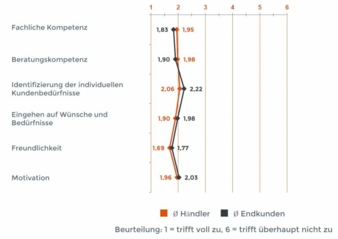09/09/2020 – Setting the course for the future now — auf Deutsch lesen
Stationary retail does not draw on its own potential
“The Stationary Retail Trade 2020” study shows where retail fails and how retailers are now setting the course for the future.
Stationary retailers have been fighting the online market – and not just since Covid-19. This is despite the fact that end customers still see clear advantages in shopping retail.
This includes being able to inspect the goods (52.5 percent), direct availability (28.0 percent), and the possibility of advice from the sales staff (22.8 percent). In particular, the retail sector does not sufficiently use the latter as a unique selling point, as a current study shows.
For the “The Stationary Retail Trade 2020” study, 577 end customers and 133 stationary retailers from a wide variety of industries were surveyed. It was carried out by the German Institute for Marketing on behalf of Sickel und Team.
Insufficient Identification of Customer Needs
If end customers are dissatisfied with their shopping experience, this is mostly due to poor sales staff (41.7 percent). When assessing the sales force, dealers and end customers agree on five-out-of-six factors. Opinions only differ when it comes to identifying individual customer needs. End customers are more dissatisfied with this than the retailers themselves. That would be a clear advantage over online shopping.
Wrong Customer Loyalty Measures
The customer loyalty measures used by retailers are consistently rated more negatively by end customers. Retailers mainly offer coupons and (loyalty) discounts (45.9 percent), newsletters (43.6 percent) and giveaways (41.1 percent). But customers rate bonus programs, coupons and customer clubs the most positively. Only around a third of retailers offer bonus programs (34.6 percent) and customer clubs/cards (34.6 percent). Even business cards are distributed by more companies (39.8 percent) – a measure that end customers judge as the least effective.
Different Perception
In addition, the results of the study show that the unique selling points of stationary retail are perceived differently by end customers and retailers. Retailers believe that they set themselves apart from the competition via additional services (55.8 percent) and customer orientation (26.9 percent). For end customers, however, a diverse and changing assortment (35.0 percent) as well as the price-performance ratio (24.6 percent) are the top priorities.
In fact, even more end customers (65.4 percent) than retailers (48.9 percent) say there are services that are to be viewed as “special” and that make a company stand out from the competition.
Retailers are therefore currently not perceived by customers as they would like – or even know why customers buy from them.
5 Tips for a Competitive Retail Business
Christian Sickel is the founder and managing director of Sickel und Team, which sanctioned the “The Stationary Retail Trade 2020” study. The results came as no surprise to him; on the contrary: his personal experience shows that retailers often state that they have a customer experience or clear goals, but these are too vague or are not consistently implemented in everyday life. Based on the results, he gives retailers in stationary retail specific tips on how to stay competitive.
1. Offer structured customer experiences
A quarter of the companies surveyed in the study (25.6 percent) do not offer a clearly defined and structured customer experience. In companies that have a customer experience, only 40 percent of the cases include a unique selling point (USP). However, retailers need exactly this customer experience with a USP in order to stand out from the competition.
2. Communicate clear goals
In more than a fifth of the companies (21.1 percent), no sales targets are communicated. That means the sales force does not know what is expected of them and when they had a successful day. But in order to sell successfully, the sales force must know their own goals.
3. Establish regular measurement cycles
Over half of the companies surveyed (54.1 percent) do not have regular measurement cycles. However, only with established measurement cycles can the sales staff's potential for improvement be reliably identified.
4. Embrace holistic customer advice
Customers rate the identification of their individual needs worse than the retailers themselves. In order to set themselves apart from the competition and, above all, from online trading, the sales staff must be able to recognize individual customer requests and respond to them. Salespeople do not just have to be trained for holistic customer advice – it must also be pursued from management on down to the individual employee.
5. Use customer loyalty measures correctly
Dealers currently rely on customer loyalty measures that customers only classify as effective to a limited extent. This is due to the choice of measures on the one hand, but also to the implementation by the sales staff on the other. However, the retail sector needs effective customer loyalty measures in order to remain competitive. This can be, for example, the personal relationship to the sales force via holistic customer advice.
About the “The Stationary Retail Trade 2020” Study
“The Stationary Retail Trade 2020” study was commissioned by Sickel und Team and carried out from the German Institute for Marketing under the direction of Prof. Dr. Michael Bernecker. From January to March 2020, 133 retailers and 577 end customers were surveyed about the topics of sales, customer satisfaction and success in stationary retail. The dealers questioned come from a wide variety of retail sectors and, measured by the number of employees and annual sales, represent both smaller and larger companies. The end customers surveyed are on average 45 years old and mostly employed (58.7 percent). The gender distribution is balanced.




